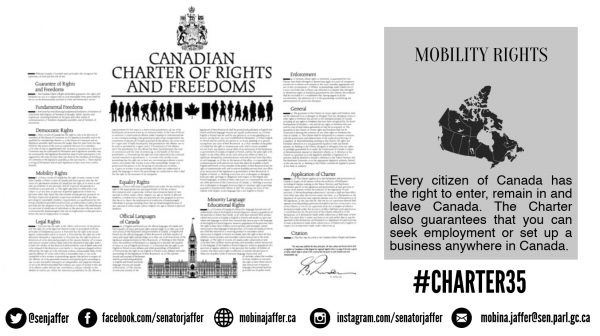
From this week onwards, my blog will be moving on to cover a different right from the Canadian Charter of Rights and Freedoms: the mobility rights within Section 6!
The basic purpose of the mobility rights is simple- they allow Canadians to go wherever they wish without government interference. However, since the Charter’s signing in 1982, several landmark cases have created interpretations of section 6 that go far beyond its literal meaning!
Today, I will provide an overview of the mobility rights found in Sections 6(1) and 6(2), which will act as context for future blogs!
The first of the two sections, section 6(1), allows for Canadians to pursue opportunities around the world and come back whenever they wish:
6. (1) Every citizen of Canada has the right to enter, remain in and leave Canada.
This subsection has become increasingly important in recent years, as globalization provides Canadians with an ever-increasing amount of opportunities, such as education or jobs.
Thanks to section 6(1), Canadians can enjoy these opportunities around the world, and will always be welcomed back into Canada when they choose to return.
While Section 6(1) deals primarily with the rights of Canadians travelling abroad, Section 6(2) focuses more on those moving within the country and reads as follows:
(2) Every citizen of Canada and every person who has the status of a permanent resident of Canada has the right
a) to move to and take up residence in any province; and
b) to pursue the gaining of a livelihood in any province.
This was particularly important at the time of the Charter’s signing, as laws made with the intention of restricting mobility between the provinces were very common.
For example, Newfoundland created laws that gave priority jobs to local residents in the area when its offshore oil fields were being developed at the time! Further, many of the richer provinces imposed residency requirements for social benefits to ensure that people from poorer provinces could not move in.
Thanks to the Charter, these laws no longer exist. Thanks to Section 6(2), Canadians will always have the same opportunities in any given province or territory as people who were born there. They are Canadians, above all else.
Both subsections of Section 6 hold a common purpose- they both provide all Canadians with the opportunity to move wherever they like without government interference so that they can find as much success as possible!
With that said- the mobility rights not absolute. In fact, the mobility rights have even more restrictions than any of the other rights I have covered so far, since the remaining subsections of 6(3) and 6(4) have the sole purpose of placing limitations on subsections 6(1) and 6(2)!
Please look forward to next week’s blog, where I will be examining these remaining subsections, and how they work together with Section 1 of the Charter to impose reasonable limitations upon the mobility rights!